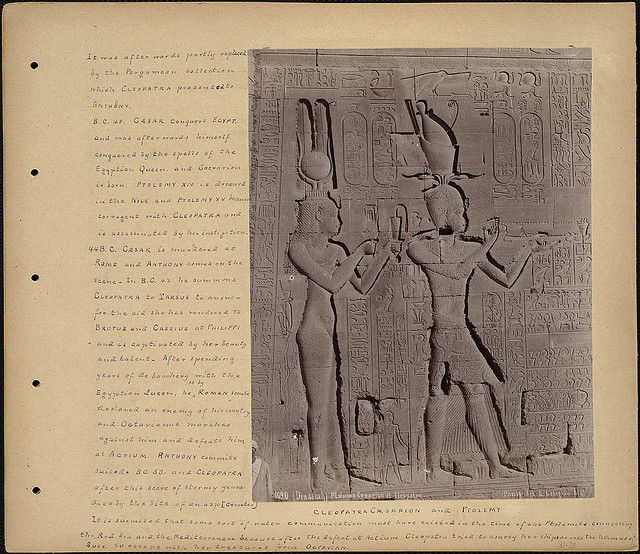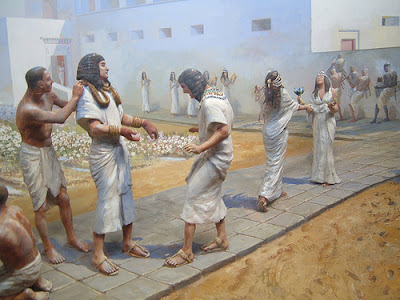Her sense of style embraced both the figure-hugging, bare-breasted fashions of Egypt and the more modest, draped Roman-style gowns, based on depictions of the Queen during her lifetime. Her headdresses and jewelry show both influences, including coins showing her with a Roman circlet on her hair and a number of carvings and paintings featuring Egyptian crowns and headdresses.
More than any other non-Egyptian ruler, Queen Cleopatra took care to master the Egyptian language. Reports from her time suggest she was a popular ruler, loved by many people. She participated in the religion, clothed herself in the local styles and presented herself in the iconography that spoke to the people. Beginning in childhood she represented an Egyptian goddess, part of the belief system that supported royalty in Egypt, and as an adult she sometimes appeared as Isis.
Facts, Pictures and Dress
The images that survive make it difficult to assess whether she was as beautiful as legends say. Her intelligence, strategic abilities and power to capture the imaginations and hearts of people continue to influence contemporary culture. Examples include Hollywood movies such as Elizabeth Taylor's role in 1963, contemporary runway fashion, and a 2012 Superbowl appearance by Madonna in what may have been a Cleopatra-inspired costume with a dramatic winged headress.
The facts of the queen's life portray her as a powerful woman was an engaging conversationalist and engaged in diplomatic correspondence in many languages. She captured the hearts of such powerful men as Caesar and Mark Antony, and left a lasting impression of greatness and style.Cleopatra's Life
Her family life bears the cut-throat markers of many royal families. She was married in succession to two of her brothers, a common practice in ancient Egyptian royal families. As a girl and young woman, she would have been surrounded by people seeking to manipulate her for their own gain, and by family members and traitors looking for opportunities to assassinate her. She held her own, ruling Egypt in her own right, and managed to be as ruthless as her life required. As a young woman she had her sister Arsinoe killed to remove her as a threat.
She was a teenager when she took Egypt's throne after her father. Four years later, at 21, she met Caesar. Despite the legends and movies that focus on her sexuality and her ploy of arriving in Caesar's bedroom unrolled from a carpet, she emerges from biased distortions as a savvy ruler with a strong intellect and indomitable will. Artists have immortalized her death -- legends have it she committed suicide by snake bite to prevent being taken captive.
Appearance & Style
Damaged busts, worn coins, stylized portraits and contemporary accounts raise questions about her appearance. She captivated powerful men and led Egypt as the last of the Ptolemies to rule as pharaoh.This dress features the wide shoulder straps that were an element of many ancient Egyptian gowns for women. The wig features gold ornaments attached to the ends of the hair in a style that's timeless and sexy. The strong brows and thick eyeliner extending beyond the corners of the eye are characteristic of makeup for women -- and for men. The Egyptian-style jewelry that completed the costume include a gold armband that embraces the queen's upper arm and gold earrings.
She seems to have worn Roman and Egyptian fashions, based on surviving pictures and coins, and she probably had curly hair. Cleopatra may have had her father's prominent nose. Portraits show her with full lips and a soft face. She seems to have worn Roman hairstyles with her hair pulled back and wigs. Headdresses or circlets completed her royal look.
Note what was probably a long, finely-braided wig on the carving pictured below. Her headdress features the horns of the goddess Hathor, the sun disk and two plumes -- the upright feathers above the crown. The dress in this picture appears to be the close-fitting transparent linen popular for women's fashions in ancient Egypt for centuries. The Egyptians made linen from flax that grew along the Nile river.
Cleopatra Facts
"B.C. 48. Cæsar conquers Egypt. And was afterwards himself conquered by the spells of the Egyptian Queen. And Caerarion is born. Ptolemy XIV is drowned in the Nile and Ptolemy XV becomes co-regent with Cleopatra and is assassinatd by her instigation.
44B.C. Cæsar is murdered at Rome and Anthony comes on the scene- In B.C. 42 he summons Cleopatra to Tarsus to answer for the aid she has rendered to Brutus and Cassius at Philippi and is captivated by her beauty and talent. After spending years of debauchery with the Egyptian Queen, he is by Roman senate declared an enemy of his country and Octavinus marches against him and defeats him at Actium. Anthony commits suicide.
BC 30 and Cleopatra after this scory of stormy years dies by the bite of an asp (cerastes). It is surmised that some sort of water communication must have existed in the time of the Ptolemies connecting the Red Sea and the Mediterranean because after the defeat at the Actium Cleopatra tried to convey her ships across the Isthmus of Suez to escape with her treasures from Octavian."
This 17th century painting presents the last Egyptian queen reaching for an asp to end her life.
Explore ideas for costumes and clothing based on this famous Queen of the Nile. Her dress and fashion sense—both the historical and Hollywood versions—offer inspiration for contemporary fashion and ancient Egyptian costumes.
Updated December 2013. Copyright Bat Hughes, all rights reserved.
Ancient Egypt: Queen Cleopatra -- Facts, Pictures and Dress
Canadian Museum of Civilization: Mysteries of Egypt: Clothing and Adornment
From Warrior Women to Female Pharaohs: Careers for Women in Ancient Egypt
Protected by Copyscape. Do not Copy.



